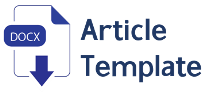Online Submissions
Already have a Username/Password for JPKS (Jurnal Pendidikan dan Kajian Seni)?
Go to Login
Need a Username/Password?
Go to Registration
Registration and login are required to submit items online and to check the status of current submissions.
Author Guidelines
AUTHOR GUIDELINES
Journal of Education and Art Studies (JPKS)
Journal of Education and Art Studies (JPKS) publishes articles concerning issues of education and learning of research results and studies in art and art education. The editorial board of the Journal of Education and Arts Studies (JPKS) invites teachers, lecturers, students, practitioners and researchers to publish their writing.
A. Submission of manuscripts- The Manuscripts submitted to Journal of Education and Art Studies (JPKS) are original manuscripts of research and studies in art and art education that have not been published in any journals either nationally or internationally or are not being proposed in other journals and are not the result The plagiarism by others as evidenced by the original statement of originality.
- The manuscript is typed in Indonesian or English with Microsoft Word program, Times New Roman letter, 12 pts size, with space 1.5. The manuscript is printed on a 10-20-page A4 paper.
- The manuscript is uploaded online by creating an account as an author by registering through the page http://jurnal.untirta.ac.id/index.php/JPKS/index or by e-mail: jurnalseni_jpks@untirta.ac.id or sendratasikfkip @ Untirta.ac.id
- The manuscript is reviewed in blind review by the reviewers who have been appointed in accordance with the field of expertise The author is given an opportunity to revise the manuscript based on recommendations / suggestions from reviewers or editors. The Publishing or rejection of the manuscript will be notified in writing.
B. Systematics of articles
Systematics of article writing research results and studies in the field of art and art education consists of: Title; Author's name; Abstract and Keywords; Introduction; Method; Results and Discussion; Conclusion; and References.
- The title should be short (maximum of 12 words in Indonesian and maximum 10 words in English), straightforward and informative (able to describe the main content of the writing). The title is printed in capital letters in the middle, with the size of 18 pts
- Author's Name is listed without an academic degree, with the name and address of the institution, and placed under the title of the article. The author should include a correspondence or e-mail address
- Abstract is written in Indonesian and English with a maximum length of 250 words containing the main issues, research objectives, methods and research results. The number of keywords is around 3-5 words or a combination of words. Abstract typed with Times New Roman font, 11 pts with single spacing
- Introduction contains background, research context, literature review, and research objectives. The entire introductory section is presented in an integrated form in paragraphs, with a length of 15-20% of the total length of the article
- The method consists of research design, data sources, data collection techniques, and data analysis conducted by researchers, with a length of 10-15% of the total length of the article
- Results and Discussion contains detailed descriptions of all research results along with its analysis. The results can be completed with tables, graphs, drawings and / or charts. The discussion contains the meaning of results and comparison with the theory and / or the results of similar research. The length of results and discussion is about 40-60% of the total length of the article.
- The conclusion is the overview of the discussion which contains research findings in the form of answers to research questions. The conclusion section should also put forward the implications of research results for the development of science and technology. The conclusions are presented in paragraph form, with a length of 5-10% of the total article.
- References only contains the sources referred in the manuscript. The sources of references used 80% in the form of primary sources such as scientific journals or research reports and published in the last 10 years.
Submission Preparation Checklist
As part of the submission process, authors are required to check off their submission's compliance with all of the following items, and submissions may be returned to authors that do not adhere to these guidelines.
- The submission has not been previously published, nor is it before another journal for consideration (or an explanation has been provided in Comments to the Editor).
- The submission file is in OpenOffice, Microsoft Word, RTF, or WordPerfect document file format.
- Where available, URLs for the references have been provided.
- The text is single-spaced; uses a 12-point font; employs italics, rather than underlining (except with URL addresses); and all illustrations, figures, and tables are placed within the text at the appropriate points, rather than at the end.
- The text adheres to the stylistic and bibliographic requirements outlined in the Author Guidelines, which is found in About the Journal.
- If submitting to a peer-reviewed section of the journal, the instructions in Ensuring a Blind Review have been followed.
- Bibliography and citations are conducted by using application reference such as mendeley, zotero, etc.
Privacy Statement
The names and email addresses entered in this journal site will be used exclusively for the stated purposes of this journal and will not be made available for any other purpose or to any other party.
Author Fees
This journal charges the following author fees.
Article Publication: 250000.00 (IDR)
If this paper is accepted for publication, you will be asked to pay an Article Publication Fee to cover publications costs.
If you do not have funds to pay such fees, you will have an opportunity to waive each fee. We do not want fees to prevent the publication of worthy work.


